L9: Post transcriptional regulation + translation review
1/18
Earn XP
Description and Tags
A collection of flashcards based on the key concepts covered in the BMOL 30030 Regulation of Gene Expression lecture notes.
Name | Mastery | Learn | Test | Matching | Spaced |
|---|
No study sessions yet.
19 Terms
Post-transcriptional gene regulation:
Post-transcriptional regulation is regulation of Translation or RNA itself that occurs after the transcription of mRNA from DNA, affecting gene expression and protein synthesis.

Translation (review)
the reading of codons (triplets of bases) to assemble amino acids (RNA to Protein) by the ribosome.
mRNA is NOT converted into protein true/ false?
True, mRNA must first undergo translation before resulting in protein synthesis, unstable
Ribosome differences b/w eukaryotes + prokaryotes
Prokaryote: 70S overall size + 30S small subunit
Eukaryote: 80S overall size + 40S small subunit
Ribosome - structure composed of rRNA and proteins; it facilitates the translation of mRNA into proteins by providing a site for tRNA to add amino acids, forming polypeptides.
Why is being ‘in frame important’ ?
Reading out of frame would change the amino acids → frameshift mutations) and thus render the code obsolete….
Codons are thus key
• The mRNA must also thus have a stop codon i.e. UAG, UGA to end translation
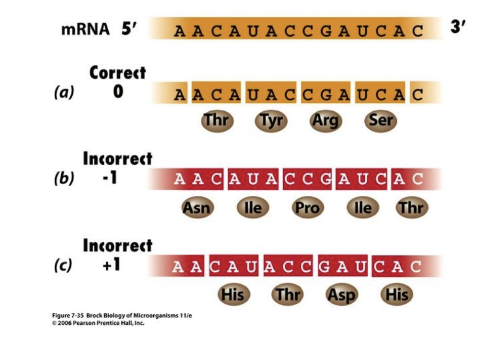
What are the 3 sites of the ribosome and their functions? - review
A (aminoacyl) - where incoming tRNA brings the next AA
P (peptidyl) - holds the tRNA carrying the growing polypeptide chain
E (exit) sites - where empty tRNA exits the ribosome after delivering its amino acid.
These sites are crucial for the binding of tRNA and the formation of polypeptides during translation.
What is the structure of the tRNA molecule and its function?
Has a cloverleaf structure that includes an anticodon at one end and an amino acid attachment site at the other *critical for translation by matching them with the corresponding codons on the mRNA.
Transport specific AAs to the ribosome during protein synthesis, ensuring accurate translation of mRNA codons into polypeptide chains.
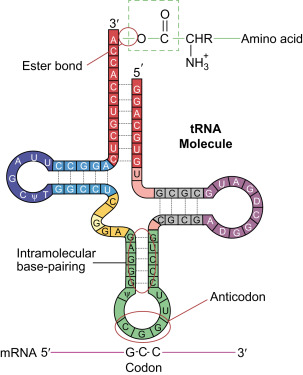
What is the Shine-Dalgarno sequence and its importance for the start of translation?
The Shine-Dalgarno sequence is a ribosomal binding site in bacterial mRNA, critical for initiating translation.
Sequence is complementary with the 3’ seq of the 16S rRNA (part of 30S) of the ribosome, ensuring that the ribosome correctly positions itself at the start codon.

what is the principle of elongation / reading of mRNA?
tRNAs anti-codons match up with mRNA codons.
Peptide bonds form between AAs
Uncharged tRNAs removed
Thus polypeptide chain is produced
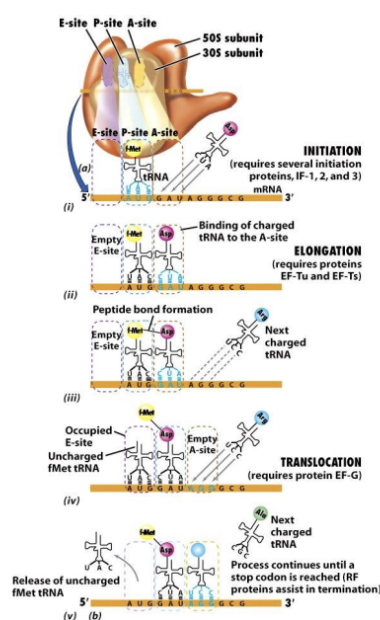
what is the principle of translational termination?
• No tRNA will bind to the stop codon.
• Instead specific proteins called release factors bind and cleave polypeptide releasing it.
This process signals the end of translation, allowing the ribosome to disassemble and release the newly synthesized protein.

What is the Stringent response?
A regulatory mechanism in bacteria that adjusts metabolism and gene expression in response to nutrient deprivation or stress → bacteria wants to save energy and turn down translation.
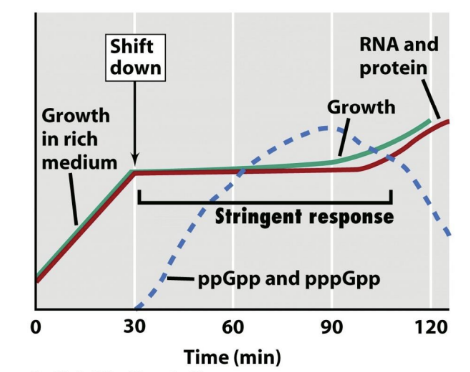
What molecule mediates the stringent response?
(p)ppGpp
A modified nucleotide called an alarmone
• Synthesised by RelA
• RelA associated with 50S subunit will produce pppGpp and
ppGpp when shortage of charged tRNA.
• These then affect transcription of rRNA and tRNA genes
*a mix of both transcriptional and post-transcriptional regulation (sensing lack of tRNAs)
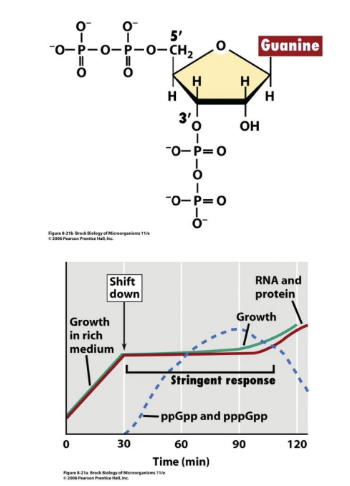
How is ppGpp an example of a global regulator?
Helps reprogram the bacterial cell's metabolic pathways to prioritise essential functions during adverse conditions by reducing translation and affecting gene expression.
Turn down rRNA and tRNA genes
Turn up various operons involved in AA biosynthesis.
However the effect is at the level of transcription as alarmones affect transcription of these genes.

When do alarmones turn off Translation / Ribosome Production?
The ppGpp response / stringent response is transcriptional regulation – acts through RNAP but is activated post-transcriptionally.
• Shows the ability to “turn off” the translational machinery when amino acids are running low or stress experienced
what are negative effects of alarmones?
Directly binding to RNAP and affecting the ability to form an open complex - transcriptional inhibition
Indirectly by affecting GTP levels
Exact molecular mechanism may vary and still in doubt
How is proteomics related to investigating post-transcriptional regulation?
Used to identify new global regulators of gene expression which function post-transcriptionally
• One example is HFQ
what is the function of sRNAs?
sRNAs regulate gene expression at the post-transcriptional level by base pairing with mRNAs influencing their stability and translation, thus impacting various cellular processes.
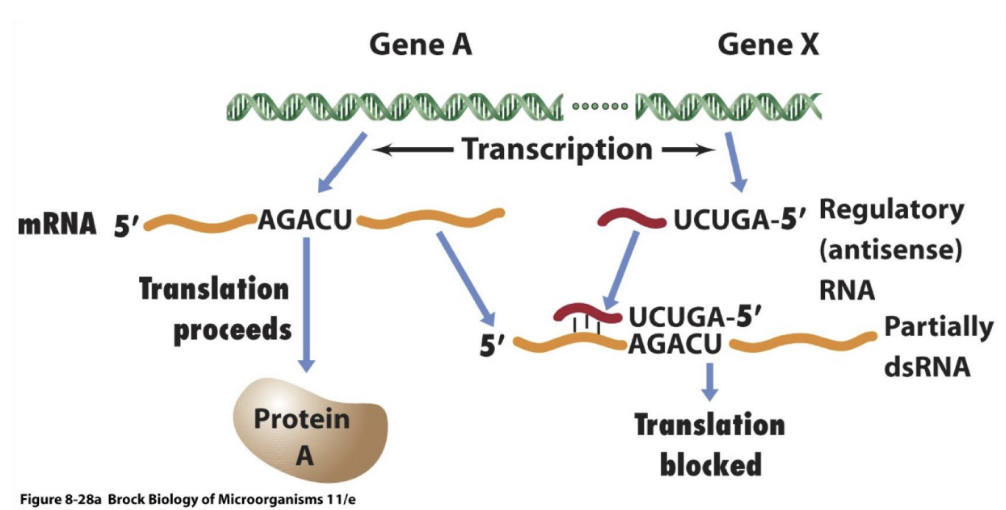
What is HFQ?
HFQ is a global regulator of gene expression that facilitates the interaction between sRNAs and their target mRNAs, protects sRNAs from RNAses promoting post-transcriptional regulation.
Related to:
Attenuated virulence in Balb/c mice
Reduced replication in MPs
Reduced host cell adhesion and invasion in vitro.
Defective secretion of effector proteins
What is the mode of action of HFQ?
HFQ is NOT a transcriptional activator/repressor
An RNA binding protein which interacts with many small regulatory RNAs
HFQ seems to act as a chaperone for the reaction between mRNA and sRNA